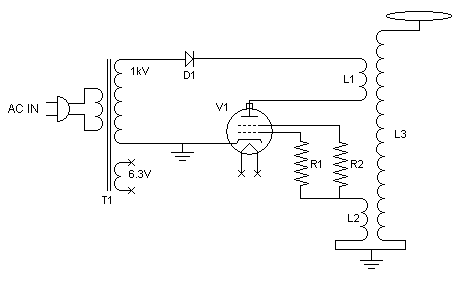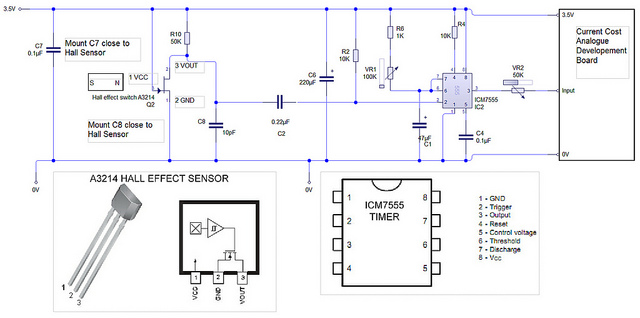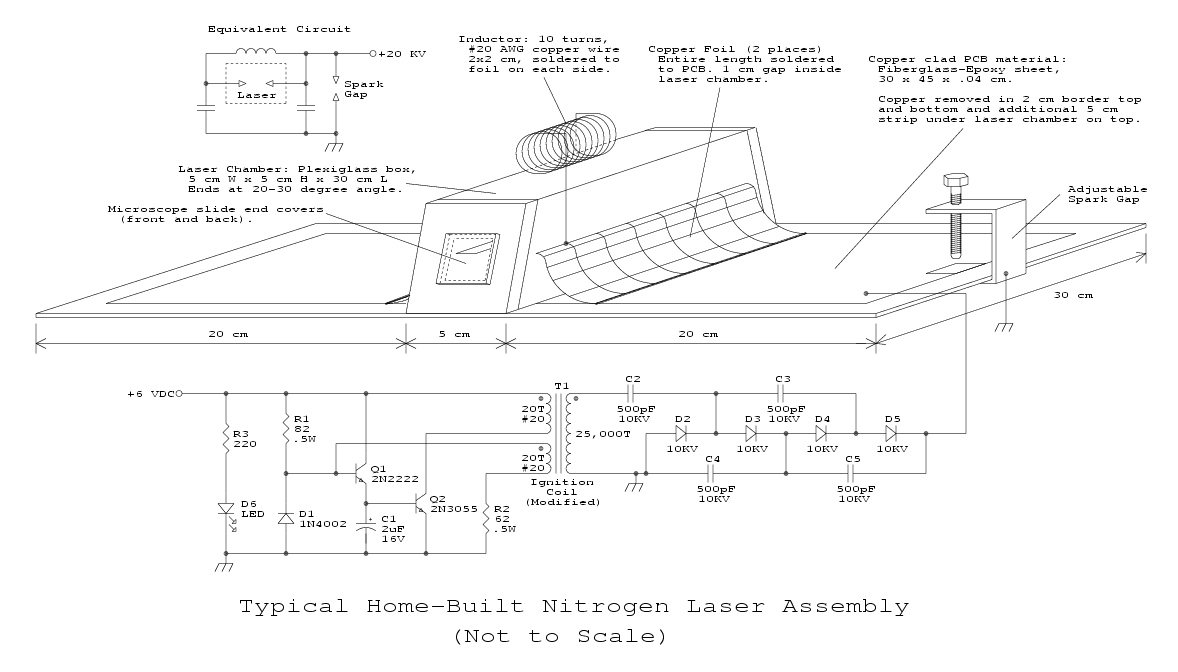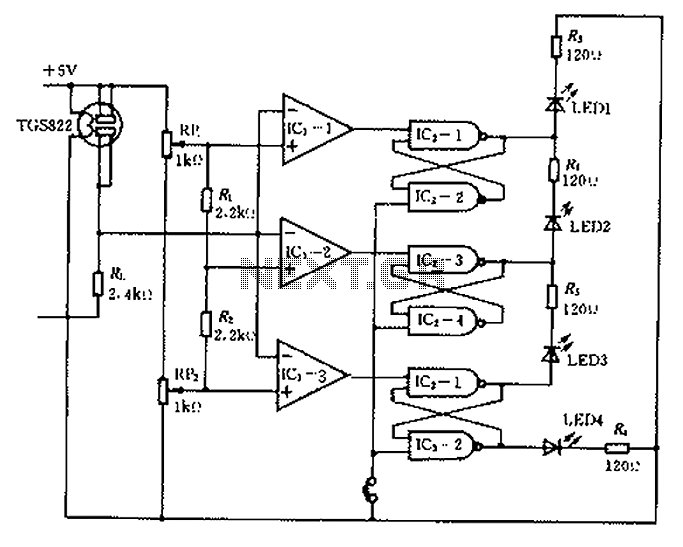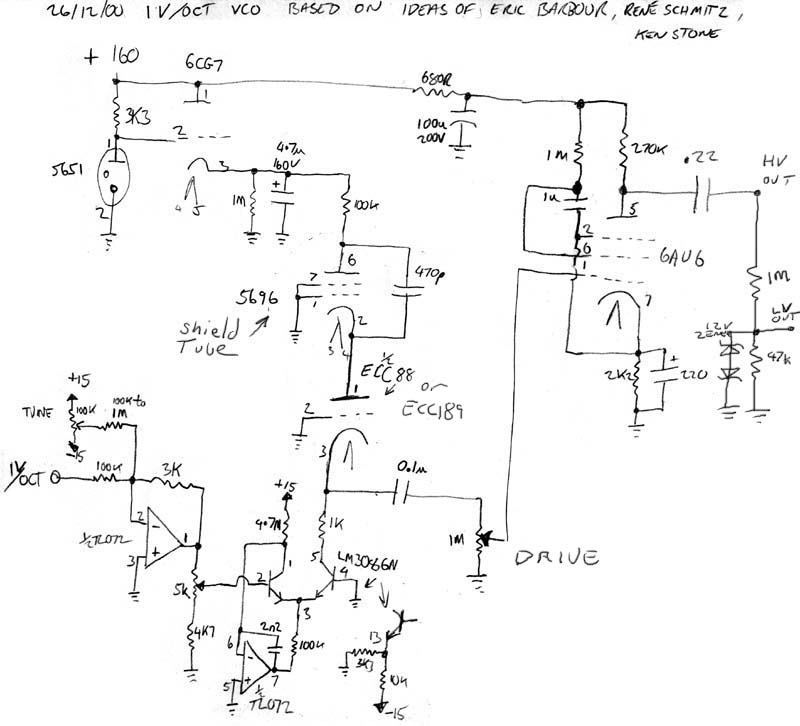
Vacuum Technology for Home-Built Gas Lasers
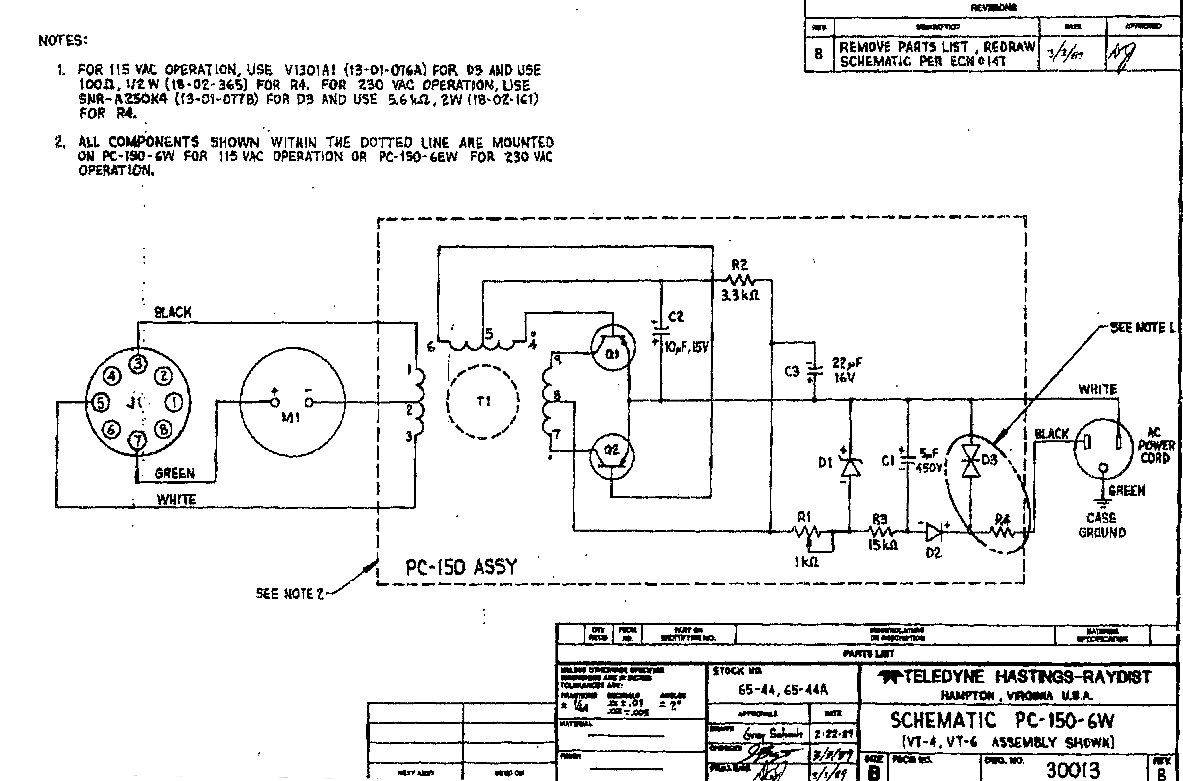
Many areas of scientific research and industrial production require vacuum conditions, where most of the air has been removed, leaving little or nothing behind. Although written specifically for home-built gas lasers, much of the following information is applicable to other medium to high vacuum systems and includes general testing, maintenance, and repair information not found elsewhere. All but one of the gas lasers described in the chapters on specific home-built lasers require a decent vacuum system to remove air from the laser tube so that it can be back-filled with the required lasing gases at low pressure. These lasers include HeNe, Ar/Kr, CO2, HeHg, CuCl/CuBr, and multiple gas (PMG) lasers. The N2 laser requires only a low vacuum since it operates at a substantial fraction (e.g., perhaps 20%) of atmospheric pressure, and some versions can run at ambient pressure (1 atm). It is essential to remove nearly all the air from the apparatus. For almost all the gas lasers described, air is detrimental and must be purged from the tube before the required gases can be admitted. Only with most of the air removed can proper and efficient lasing action occur. Even a small amount of residual air may lead to erratic or weak operation, or no output beam at all. It is necessary to pump out residual gases resulting from outgassing from glass, seals, adhesives, fingerprints, and other contaminants on the surface and in the crevices of the laser tube assembly. Certain materials, like vacuum grease, do not cause issues; however, a single fingerprint can serve as a significant source of unwanted vaporous contamination.
The pressure of the gas fill must be controlled as individual gases or gas mixtures are admitted to the apparatus, either prior to or during operation, as the electrical discharge buries gas molecules under sputtered electrode material or chemical reactions affect the proportion of each type of gas. According to vacuum industry standards, the requirements for the vacuum systems described are modest and are generally classified as "medium" vacuum. This does not necessitate the removal of every last "particle" of air but aims for a pressure range of 1/100th to 1/10,000th of normal atmospheric pressure. These conditions are not typically considered a "high" vacuum, though they may be listed as such in catalog listings for mechanical vacuum pumps and gauges used. Nevertheless, achieving a vacuum significantly lower than the operational pressure of the laser is advantageous for filling the laser with predominantly pure gases, extending into the upper range of high vacuum, down to approximately 1,000,000th of normal atmospheric pressure.
The process of assembling a vacuum system may involve acquiring parts or seeking out surplus vacuum equipment, particularly smaller items rather than complete ion beam machines. Resources such as the EE-527 Vacuum Systems Page of the Center for Applied Microtechnology at the University of Washington provide an overview of various aspects of vacuum technology, including diagrams and links to additional information on related topics. Furthermore, foundational resources like "Vacuum Basics" offer a comprehensive introduction to vacuum terminology and applications, while Phil Danielson's Journal of Practical and Useful Vacuum Technology serves as a valuable reference for practical insights into vacuum technology.
In summary, achieving the appropriate vacuum conditions is critical for the efficient operation of gas lasers. The removal of air and control of gas fill pressure are essential to ensure optimal performance, and various resources are available to assist in understanding and implementing vacuum systems in both research and industrial contexts.Many areas of scientific research and industrial production require vacuum conditions - where most (or as much as possible) of the air has been removed leaving little or nothing behind. While written specifically for the needs of home-built gas lasers, much of what follows is applicable to other medium to high vacuum systems and includes some general testing, maintenance,
and repair information not found elsewhere. All but one of the gas lasers described in the chapters on specific home-built lasers require a decent vacuum system to remove air from the laser tube so that it can be back-filled with the required lasing gases at a low pressure. These include the HeNe, Ar/Kr, CO2, HeHg, CuCl/CuBr, and multiple gas (PMG) lasers. The N2 laser requires only a `low` vacuum since it runs at a substantial fraction (e. g. , perhaps 20%) of atmospheric pressure and some versions can run at ambient pressure (1 atm). Remove (nearly) all the air from the apparatus. For almost all the gas lasers we will be describing, air is poison. It must be purged from the tube before the required gases can be admitted. Only with most of the air gone, can proper and efficient lasing action take place. Even a small amount of residual air may result in erratic or weak operation - or no output beam at all!
Pump out residual gases resulting from outgassing from the glass, seals, adhesives, finger prints, and other contamination on the surface and in the crevices of the laser tube assembly. Some materials like vacuum grease do not cause problems. However, a single finger print can represent a veritable reservoir of unwanted vaporous contamination!
Control the pressure of the gas fill as individual gases or gas mixtures are admitted to the apparatus either prior to or during operation as the electrical discharge buries gas molecules under sputtered electrode material or chemical reactions affect the proportion of each type of gas. By the standards of the vacuum industry, our requirements are modest and are generally called a "medium" vacuum - not the sort of situation where every last "particle" of air needs to be removed but still 1/100th to 1/10, 000th of normal atmospheric pressure.
These are not generally considered a "high" vacuum (though that`s what may be found in catalog listings for the types of mechanical vacuum pumps and gauges that are used) but they are still not the sort of thing you come across in daily life. However, to be able to fill the laser with (mostly) pure gases, it is desirable for the vacuum system to go substantially lower in pressure than that at which the laser operates.
And this includes the upper end of the high vacuum range - down to perhaps 1, 000, 000th of normal atmospheric pressure. I am gradually putting together a vacuum system (or at least acquiring parts!) and may have an interest in your cast-off or excess vacuum equipment (relatively small items, not complete ion beam machines!) or accessories.
Please see: Sam`s Classified Page, "Wanted to Acquire" near the end, if you have anything available. EE-527 Vacuum Systems Page of the Center for Applied Microtechnology at the University of Washington. This includes a very nice slide presentation-type overview (including diagrams) of many aspects of vacuum technology.
It also links to much additional information on related topics. Direct link: EE-527 Vacuum Tutorial. (Local copy of the slide show should the above link go bad: EE-527 Vacuum Tutorial. ) See The Bell Jar for an index to some articles on-line and many more available only in hard copy and/or by subscription, vacuum equipment suppliers and links. and a Readers` page which includes vacuum equipment "For Sale and Wanted" but doesn`t appear to have been updated in a couple of years.
To start, see, Vacuum Basics provides a nice introduction including vacuum terminology and applications. Phil Danielson`s Journal of Practical and Useful Vacuum Technology has a 🔗 External reference
The pressure of the gas fill must be controlled as individual gases or gas mixtures are admitted to the apparatus, either prior to or during operation, as the electrical discharge buries gas molecules under sputtered electrode material or chemical reactions affect the proportion of each type of gas. According to vacuum industry standards, the requirements for the vacuum systems described are modest and are generally classified as "medium" vacuum. This does not necessitate the removal of every last "particle" of air but aims for a pressure range of 1/100th to 1/10,000th of normal atmospheric pressure. These conditions are not typically considered a "high" vacuum, though they may be listed as such in catalog listings for mechanical vacuum pumps and gauges used. Nevertheless, achieving a vacuum significantly lower than the operational pressure of the laser is advantageous for filling the laser with predominantly pure gases, extending into the upper range of high vacuum, down to approximately 1,000,000th of normal atmospheric pressure.
The process of assembling a vacuum system may involve acquiring parts or seeking out surplus vacuum equipment, particularly smaller items rather than complete ion beam machines. Resources such as the EE-527 Vacuum Systems Page of the Center for Applied Microtechnology at the University of Washington provide an overview of various aspects of vacuum technology, including diagrams and links to additional information on related topics. Furthermore, foundational resources like "Vacuum Basics" offer a comprehensive introduction to vacuum terminology and applications, while Phil Danielson's Journal of Practical and Useful Vacuum Technology serves as a valuable reference for practical insights into vacuum technology.
In summary, achieving the appropriate vacuum conditions is critical for the efficient operation of gas lasers. The removal of air and control of gas fill pressure are essential to ensure optimal performance, and various resources are available to assist in understanding and implementing vacuum systems in both research and industrial contexts.Many areas of scientific research and industrial production require vacuum conditions - where most (or as much as possible) of the air has been removed leaving little or nothing behind. While written specifically for the needs of home-built gas lasers, much of what follows is applicable to other medium to high vacuum systems and includes some general testing, maintenance,
and repair information not found elsewhere. All but one of the gas lasers described in the chapters on specific home-built lasers require a decent vacuum system to remove air from the laser tube so that it can be back-filled with the required lasing gases at a low pressure. These include the HeNe, Ar/Kr, CO2, HeHg, CuCl/CuBr, and multiple gas (PMG) lasers. The N2 laser requires only a `low` vacuum since it runs at a substantial fraction (e. g. , perhaps 20%) of atmospheric pressure and some versions can run at ambient pressure (1 atm). Remove (nearly) all the air from the apparatus. For almost all the gas lasers we will be describing, air is poison. It must be purged from the tube before the required gases can be admitted. Only with most of the air gone, can proper and efficient lasing action take place. Even a small amount of residual air may result in erratic or weak operation - or no output beam at all!
Pump out residual gases resulting from outgassing from the glass, seals, adhesives, finger prints, and other contamination on the surface and in the crevices of the laser tube assembly. Some materials like vacuum grease do not cause problems. However, a single finger print can represent a veritable reservoir of unwanted vaporous contamination!
Control the pressure of the gas fill as individual gases or gas mixtures are admitted to the apparatus either prior to or during operation as the electrical discharge buries gas molecules under sputtered electrode material or chemical reactions affect the proportion of each type of gas. By the standards of the vacuum industry, our requirements are modest and are generally called a "medium" vacuum - not the sort of situation where every last "particle" of air needs to be removed but still 1/100th to 1/10, 000th of normal atmospheric pressure.
These are not generally considered a "high" vacuum (though that`s what may be found in catalog listings for the types of mechanical vacuum pumps and gauges that are used) but they are still not the sort of thing you come across in daily life. However, to be able to fill the laser with (mostly) pure gases, it is desirable for the vacuum system to go substantially lower in pressure than that at which the laser operates.
And this includes the upper end of the high vacuum range - down to perhaps 1, 000, 000th of normal atmospheric pressure. I am gradually putting together a vacuum system (or at least acquiring parts!) and may have an interest in your cast-off or excess vacuum equipment (relatively small items, not complete ion beam machines!) or accessories.
Please see: Sam`s Classified Page, "Wanted to Acquire" near the end, if you have anything available. EE-527 Vacuum Systems Page of the Center for Applied Microtechnology at the University of Washington. This includes a very nice slide presentation-type overview (including diagrams) of many aspects of vacuum technology.
It also links to much additional information on related topics. Direct link: EE-527 Vacuum Tutorial. (Local copy of the slide show should the above link go bad: EE-527 Vacuum Tutorial. ) See The Bell Jar for an index to some articles on-line and many more available only in hard copy and/or by subscription, vacuum equipment suppliers and links. and a Readers` page which includes vacuum equipment "For Sale and Wanted" but doesn`t appear to have been updated in a couple of years.
To start, see, Vacuum Basics provides a nice introduction including vacuum terminology and applications. Phil Danielson`s Journal of Practical and Useful Vacuum Technology has a 🔗 External reference
